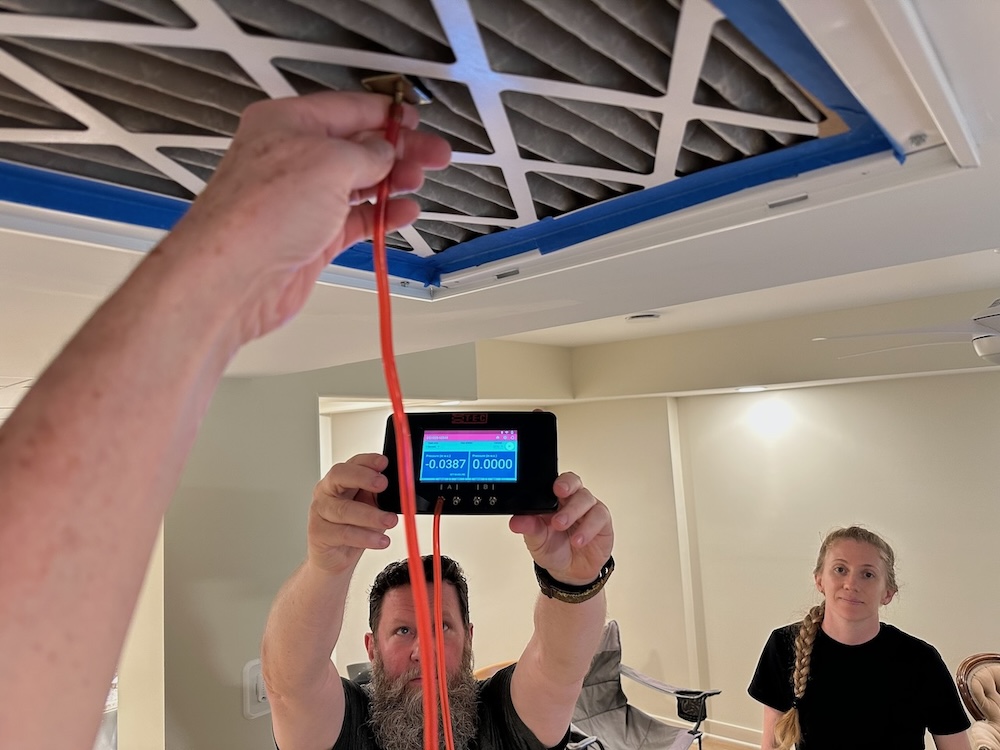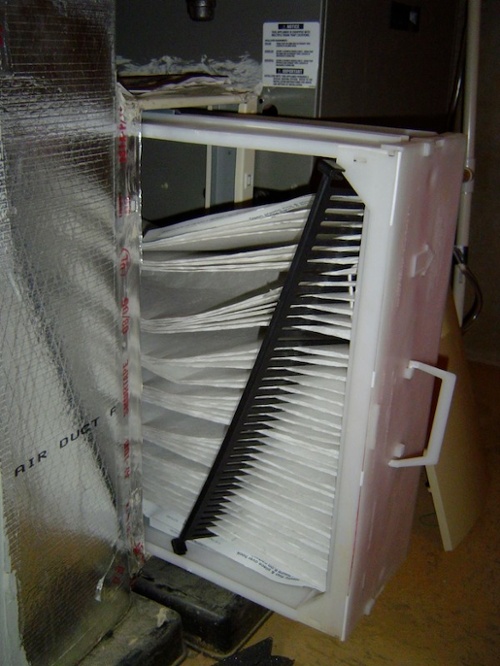High-Efficiency Filtration Essentials

Over the past seven years or so, I’ve written a bunch of articles about high-efficiency filtration. I’ve covered everything from how filtration fits into a good indoor air quality (IAQ) plan to why high-MERV filters often don’t work to the details that ensure they will work…and a lot of stuff in between. Today I’m going to give you a brief summary of what I’ve written in all these articles. I’m also providing links to the previous articles down at the bottom, so it’ll all be here in one place.
Why you want high efficiency filtration
Your heating and cooling system can move—and filter—a lot of air. What standard media filters remove is particles. Gases pass right through. There are several physical mechanisms that cause particles to get stuck to the filter media, and one of the particle characteristics that has a big effect on capture efficiency is size.
For good indoor air quality, the particles that are most important to remove are the small ones. Specifically, you want to remove as many of the particles that are 2.5 microns (aka PM2.5) or smaller. They’re the ones that can deep into your respiratory system. From the lungs, they can get into the bloodstream. From the blood, they find the heart, the brain, and other places where you don’t want them accumulating.
The standard 1-inch fiberglass filter (MERV 2) will remove the larger particles passing through but have little to no effect on the small particles. To catch more of the smaller particles, you need to use filters with higher efficiency. The MERV scale goes from 1 to 16, so you want double digits for good IAQ.
The essentials of making high-efficiency filtration work
A lot of pros in the fields of filtration, indoor air quality, and HVAC have settled on MERV 13 as the ideal combination of filtration efficiency and low resistance to air flow. Of course, you can do MERV 16 in a house. You just need to make sure that you have enough filter area. Todd Usher’s home-building company, Addison Homes, puts MERV 16 in all their homes.
An important ratio
The reason so many high-efficiency filters don’t work is that there’s too much air flow for the size of the filter. Or, in other words, the filter is too small for the HVAC system. So getting a large enough ratio of filter area to air flow rate is the key. The number we use is 2 square feet of filter area per 400 cubic feet per minute (cfm) of air flow is the threshold. We often make the filter—and that ratio—even bigger. We also specify filters that are at least 2 inches deep. See the full article on filter sizing more details.
Don’t squeeze the air
Another important factor that helps you do high-efficiency filtration is making sure there’s enough space behind the filter. I found this out when I installed a new ducted mini-split heat pump with MERV 13 filters in my house in 2019. After it was done and I tested it, the pressure drop across the filters wasn’t quite as low as it should have been. So I made more space behind the filter. Read about it here.

Eliminate bypass
If you really want to do a good job filtering the air, you need to make sure all the air goes through the filter. You don’t want any air bypassing the filter. At the filter itself, you may need to add tape or weatherstripping to eliminate bypass. The photo below shows a high-efficiency filter with a huge bypass. In the video lower down in this article, I discuss how I used tape to get rid of bypass in a filter grille.

The proof is in the pressure
As you’ll see in some of the other articles in this series (links below), this isn’t just a theoretical exercise. The protocol we use is based on actual performance testing. The most recent testing we did was in the new heat pump we put in my basement during our renovation.
The lead photo at the top of this article shows that we measured 0.039 inch of water column (iwc) across the MERV 13 filter. Now, that may not mean much to you, but let me put in perspective.
The duct design standard (Manual D) from the Air Conditioning Contractors of America (ACCA) says designers should use 0.1 iwc for the pressure drop across a clean filter. So, compared to the design standard, this system has a filter with ~40 percent less resistance. And that was with a dirty filter. When we changed the filter, we got 0.026 iwc. That’s a quarter of the design standard!
In short, yes, you can have high-efficiency filtration with MERV 13 (or even higher) filters in your home. You just need to design and install it properly.
Allison A. Bailes III, PhD is a speaker, writer, building science consultant, and the founder of Energy Vanguard in Decatur, Georgia. He has a doctorate in physics and is the author of a bestselling book on building science. He also writes the Energy Vanguard Blog. For more updates, you can follow Allison on LinkedIn and subscribe to Energy Vanguard’s weekly newsletter and YouTube channel.
Related Articles
7 Steps to Good Indoor Air Quality
Which Indoor Air Pollutants Matter Most?
The Path to Low Pressure Drop Across a High-MERV Filter
How to Make a Good High-MERV Filter Even Better
My Low Pressure-Drop, MERV-13 Filters
Understanding Filter Ratings: MERV, FPR, and MPR
Do High-MERV Filters Always Reduce Air Flow?
The Unintended Consequences of High-MERV Filters
7 Reasons Your Filter Isn’t Improving Your Indoor Air Quality
The Advantages of Filter Grilles for Your HVAC System
3 Ways to Get Cleaner Indoor Air With Filtration
Comments are welcome and moderated. Your comment will appear below after approval. To control spam, we close comments after one year.

Great article!!! Thank you.
Would LOVE more info about the device you are using, and an article about methods for the average homeowner can measure pressure drop across a filter.
There are so many different filters out there rated MERV13, and visually they look VERY different -ie number of pleats, how much light you can see through, etc. The 1″ ones are also FAR less expensive than the 2″, so if my pressure drop across 1″ is ok, I could stop worrying about whether I have enough space behind the filter to upgrade to a 2″ filter grills
I’d like to set up some sort of system that stays installed and alerts me when it is time to change the filter. I suspect I am changing them before it is needed, which is both a waste of money and an environmental issue, as I have not been able to figure out how to recycle filters.
cal: The device you see in the photo is the DG-1000 manometer made by The Energy Conservatory. (https://www.energyconservatory.com/product/dg-1000-digital-pressure-and-flow-gauge/) At ~$2,000, though, it’s not a homeowner’s tool for occasional filter checks.
I did write about a less expensive way to set up a $50 pressure gauge that you can keep an eye on. Here’s the link:
How Often Should You Change the HVAC Filter?
https://www.energyvanguard.com/blog/how-often-should-you-change-hvac-filter
Yeah, there definitely are different flavors of filters out there. One of these days I’ll cover that, too. Regarding the 1″ vs 2″ filters, I’d be concerned about going as thin as 1″. When you get the size right, the low pressure drop means you can leave the filter in there a long time. I typically change mine every 6 months, but I left them a whole year one time, and the pressure drop was still low.